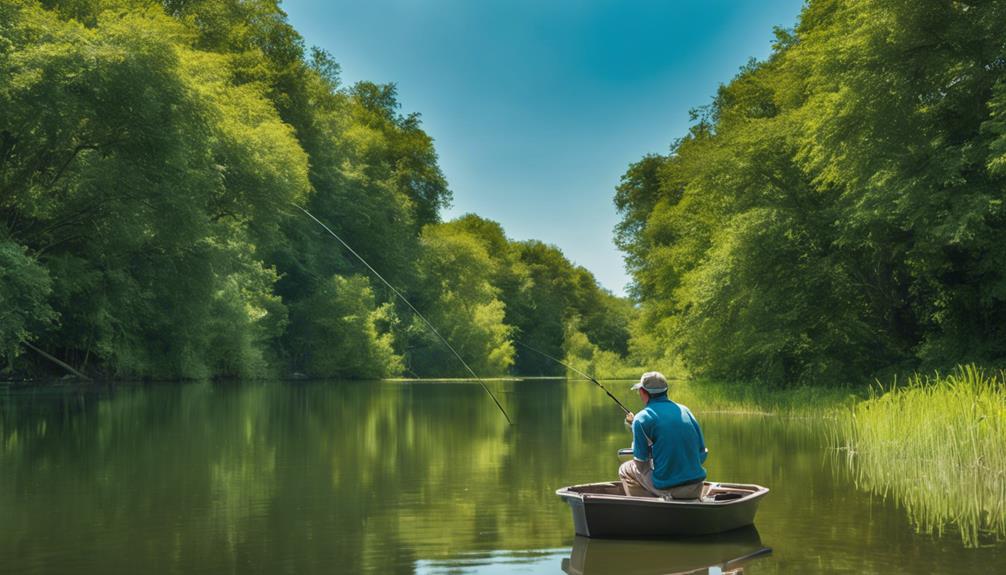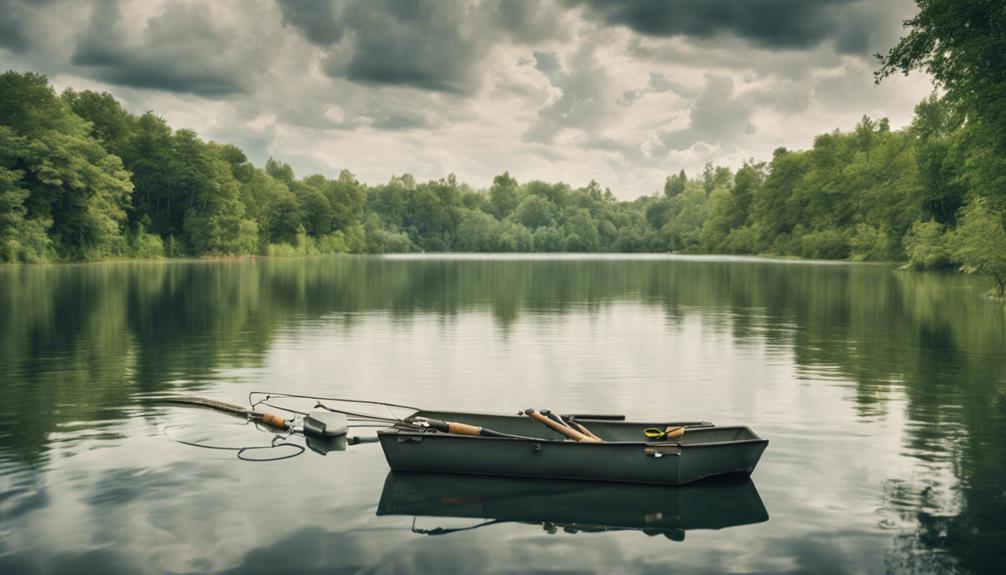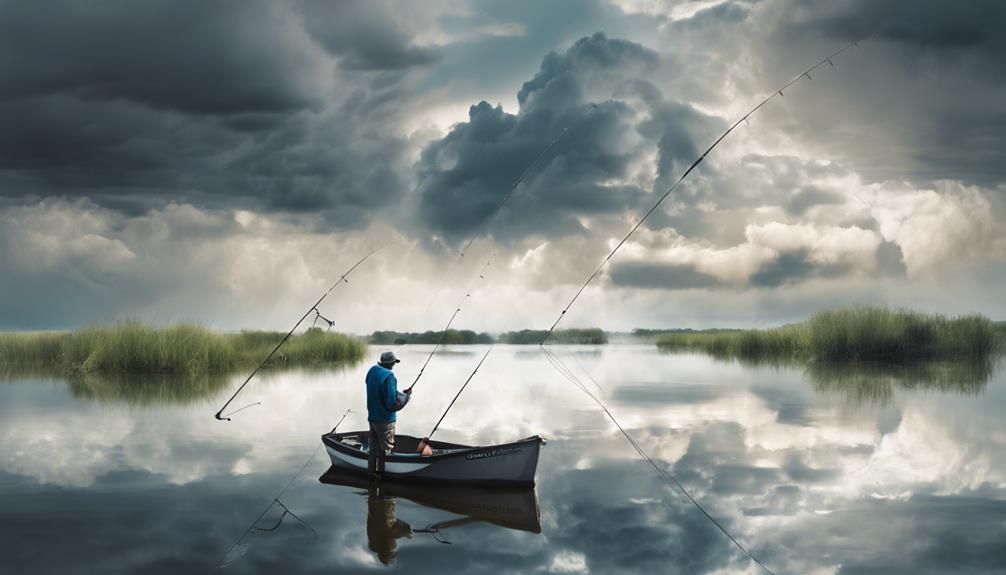Master these essential tips for freshwater angling: 1) Understand weather patterns to plan effectively. 2) Prioritize safety by checking forecasts for storms. 3) Carry communication devices for emergencies. 4) Inform someone of your plans. 5) Cloud cover affects fish behavior; adjust your strategy accordingly. 6) Wind direction can concentrate food sources; position yourself strategically. 7) Barometric pressure influences fish reactions; monitor trends and adapt. Optimizing these factors can greatly impact your fishing success. Enhance your angling experience by mastering these essential weather tips for freshwater fishing.
Importance of Weather Awareness
Understanding weather patterns is crucial for successful freshwater angling. Safety precautions should always be a top priority when planning a fishing trip. Before heading out, ensure you have checked the weather forecast for any potential storms or adverse conditions. Planning ahead can make a significant difference in your angling experience.
When it comes to safety precautions, keeping an eye on the sky is key. Sudden changes in weather can pose risks, so it's essential to have a plan in place. Always carry a fully charged phone for emergencies and consider investing in a portable weather radio for real-time updates while on the water. Additionally, informing someone of your angling plans and expected return time can be a lifesaver in case of unexpected weather changes.
Planning ahead involves more than just checking the forecast. Understanding how weather conditions can affect fish behavior is crucial. For example, sudden drops in temperature or changes in barometric pressure can impact where fish are located and how they respond to bait. By being aware of these factors, you can adjust your angling techniques accordingly to increase your chances of a successful catch. Remember, staying informed and prepared is key to a safe and productive angling experience.
Cloud Cover and Its Impact
To optimize your freshwater angling experience, consider how cloud cover influences fish behavior and your fishing strategy. Cloud cover plays a crucial role in determining the amount of sunlight reaching the water, which in turn affects fish behavior and ultimately your fishing success.
Different cloud patterns have varying impacts on fish behavior. A clear sky with no clouds allows maximum sunlight penetration into the water, which can make fish more cautious and seek shelter in deeper or shaded areas. On the other hand, heavy cloud cover can reduce sunlight penetration, making fish more active near the surface or in shallower waters. Understanding these cloud patterns can help you adjust your fishing techniques accordingly.
In bright sunlight conditions, fish may be more easily spooked by the sight of anglers or fishing lines. Therefore, using lighter lines or more natural-looking bait can increase your chances of success. Conversely, during overcast conditions, fish may be less wary, allowing for more aggressive fishing approaches.
When planning your fishing trip, keep an eye on the cloud cover forecast and adapt your strategy accordingly. Remember, understanding how cloud cover influences fish behavior can significantly impact your freshwater angling success.
Wind Direction Matters
Wind direction plays a crucial role in determining the behavior of freshwater fish and should be carefully considered when planning your angling strategy. Understanding wind patterns is essential for a successful fishing trip. Fish tend to gather in areas where food is most abundant, and wind can help carry insects or other prey to certain parts of the water, attracting fish to those locations. When the wind blows parallel to the shoreline, it pushes surface water towards one side, concentrating food sources and consequently fish in that area. Therefore, casting strategies should be adjusted accordingly.
In situations where the wind is blowing towards you, casting directly into the wind can be challenging. In such cases, it's advisable to position yourself with the wind at your back. This way, your casts will be more accurate and cover a greater distance. On the other hand, when the wind is blowing from behind the fish, it might spook them if you cast directly towards them. In these instances, it's better to cast perpendicular to the wind to avoid alerting the fish.
Understanding Barometric Pressure
Barometric pressure plays a significant role in freshwater angling, impacting fish behavior and influencing your fishing success. Pressure fluctuations, caused by weather patterns, can have a direct effect on how fish behave in the water. Understanding these fluctuations can help you adjust your angling techniques accordingly for better results.
Fish are highly sensitive to changes in barometric pressure. When pressure is high, fish tend to move towards the bottom of the water, becoming less active and feeding less. Conversely, when pressure is low, fish are more likely to move towards the surface and exhibit increased feeding activity. By tracking barometric pressure changes, you can predict fish behavior and adjust your fishing strategies accordingly.
To maximize your fishing success, it's essential to pay attention to barometric pressure trends before and during your fishing trip. Utilize resources such as weather apps or barometers to monitor pressure changes. Additionally, keeping a fishing journal to record pressure conditions and corresponding fishing outcomes can help you identify patterns over time.
Rainfall and Fishing Success
Rainfall directly impacts freshwater angling success by influencing fish behavior and habitat conditions. Understanding how rainfall affects fishing can greatly improve your chances of a successful angling trip.
When it rains, fish tend to become more active near the surface as they look for food that gets washed into the water. Additionally, rainfall can change water clarity and temperature, which in turn affects where fish congregate.
Heavy rainfall can lead to increased water flow in rivers and streams, causing fish to seek shelter in calmer areas such as eddies or behind structures like rocks and logs. On the other hand, light rain can create a feeding frenzy among fish as insects and other food sources are brought into the water. Adjusting your fishing strategies based on these rainfall effects can significantly boost your catch rates.
During periods of rain, consider using topwater lures or baits that mimic insects to attract fish feeding near the surface. If the rain has caused water levels to rise and flow faster, try targeting slower-moving pools or areas with less current where fish may be seeking refuge.
Temperature: Hot Vs. Cold
When considering freshwater angling, understanding the impact of temperature variations, whether hot or cold, is crucial for optimizing your fishing strategy. Different weather conditions require specific preparations to ensure a successful angling experience. Here are some essential tips to help you navigate the challenges posed by varying temperatures:
- Heatwave precautions: During hot weather, it's vital to stay hydrated and protect yourself from the sun's harsh rays. Wearing sunscreen, a hat, and lightweight, breathable clothing can help prevent heat-related illnesses.
- Layering strategies: In colder temperatures, layering your clothing is key to retaining body heat. Start with a moisture-wicking base layer, add insulating layers, and top it off with a waterproof outer shell to stay warm and dry.
- Winter fishing gear: When fishing in cold weather, ensure you have the right gear, such as thermal clothing, gloves, and insulated boots. Having appropriate gear will make your fishing experience more comfortable and enjoyable.
- Ice safety: If you're venturing out onto frozen lakes or rivers for ice fishing, always prioritize safety. Check the ice thickness, avoid areas with visible cracks or moving water, and carry safety equipment like ice picks and a life jacket in case of emergencies.
Morning Vs. Evening Conditions

For freshwater anglers, understanding the differences between morning and evening conditions is essential for maximizing fishing success. In the early morning, the water is often calm, with minimal wind disturbance. This calmness allows for easier casting and presentation of bait or lures. Fish tend to be more active during the morning hours, making it a prime time for angling. Additionally, the cooler temperatures of the morning can lead to increased oxygen levels in the water, further stimulating fish activity.
On the other hand, as evening approaches, the conditions shift towards a frenzy. Fish that may have been lethargic during the heat of the day become more active in search of food. The decreasing light levels trigger predatory instincts, leading to heightened feeding behavior. This evening frenzy can result in more bites and increased chances of hooking a fish. Anglers should adjust their strategies accordingly, using lures or baits that mimic the movements of prey to attract fish during this time.
Utilizing Weather Apps
To make informed decisions about your angling outings, consider incorporating weather apps into your planning process. Weather apps offer a variety of features that can help you stay ahead of changing conditions and enhance your fishing experience. Here are some key points to consider when utilizing weather apps:
- Real-Time Updates: Weather apps provide real-time updates on current weather conditions, including temperature, wind speed, and precipitation levels. This information can help you decide whether it's the right time to head out for a fishing trip.
- Hourly Forecasts: Many weather apps offer hourly forecasts, allowing you to plan your angling activities more effectively. By knowing how the weather is expected to change throughout the day, you can adjust your plans accordingly.
- Severe Weather Alerts: Weather apps can alert you to severe weather conditions such as thunderstorms, high winds, or heavy rainfall. This feature can help you stay safe while on the water and avoid potentially dangerous situations.
- Forecasting Accuracy: Weather apps use advanced algorithms and data sources to provide accurate weather forecasts. By relying on these forecasts, you can make better decisions about when and where to fish, increasing your chances of a successful angling trip.
Frequently Asked Questions
Can Fishing Be Successful During a Thunderstorm?
Fishing during a thunderstorm can be risky due to lightning safety concerns. However, with proper thunderstorm tactics, such as monitoring weather alerts and seeking safe shelter, you can stay safe while fishing.
Remember, when lightning is present, it's best to avoid being near bodies of water or exposed areas.
Always prioritize your safety during thunderstorms to prevent any potential harm.
How Does Humidity Affect Freshwater Fishing?
Humidity plays a significant role in freshwater fishing. High humidity levels can lead to warmer water temperatures, causing fish to be more active. Additionally, humidity can influence fish behavior by affecting their oxygen intake.
When humidity is low, fish may be less active and seek deeper, cooler waters. Wind speed can also impact fish activity by creating ripples on the water's surface, making it harder for them to detect predators.
Is It Safe to Fish During a Sudden Drop in Barometric Pressure?
When barometric pressure suddenly drops, fishing strategies should adapt. While it can trigger increased fish activity, it may also indicate approaching storms, making safety precautions vital. Be cautious if visibility decreases or winds pick up.
Seek shelter if lightning threatens. Use this opportunity to adjust your angling techniques, but always prioritize safety above all else when fishing during such weather changes.
Do Fish Prefer Sunny or Overcast Conditions?
When considering fishing strategies, weather patterns play a crucial role in determining success. Fish behavior in relation to sunlight preferences can vary.
Some species are more active during sunny conditions, as the light may attract prey. On the other hand, overcast conditions can be beneficial for fishing, as fish may feel more secure and be more willing to feed.
Understanding these nuances can help you adapt your approach based on current weather conditions.
How Can Moon Phases Influence Freshwater Angling?
The lunar cycle can significantly impact fish behavior and ultimately your fishing success. Moon phases play a crucial role in determining when fish are more active and feeding.
During certain moon phases, such as the full moon, fish tend to be more active at night, while other phases might influence their feeding patterns during the day. Understanding how moon phases affect fish behavior can help you plan your fishing trips more effectively.
Conclusion
In conclusion, mastering the art of freshwater angling requires a deep understanding of how weather conditions can impact your success on the water. By paying attention to cloud cover, wind direction, barometric pressure, rainfall, temperature, and time of day, you can greatly improve your chances of reeling in a big catch.
Utilizing weather apps to stay informed and adapting your strategies accordingly will set you up for a more successful and enjoyable fishing experience.



